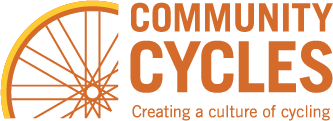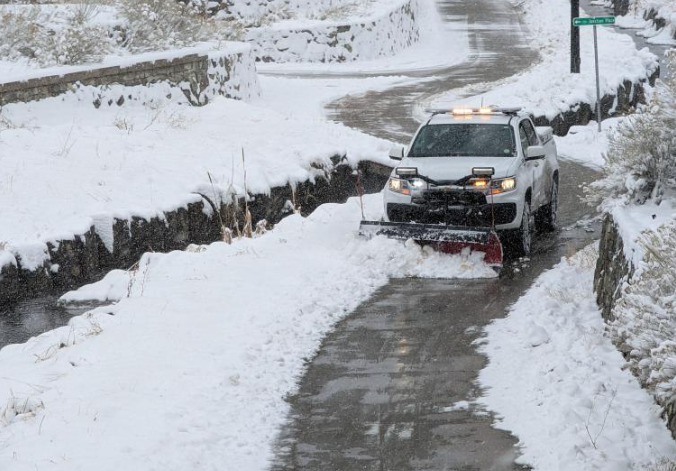Dear Transportation Dept.
Community Cycles has reviewed the Snow and Ice Response Program Update that you presented to TAB in November. It addresses several of the connections that we are concerned about. We are very pleased with the changes to both the plowed network and the methodology, and welcome the additional snowplowing described by the “Crosstown Bikeways” program, which should significantly improve bicycling during snowy times.
The additional plowing will address places such as 13th St. from Balsam to the Community Gardens path, and from the Gardens path on 15th to Iris Ave. We have seen these residential streets be icy and impassable for more than a week after a snowstorm, which makes the primary north-south corridor barely usable for bicycling. Thank you for recognizing and trying to address this need.
The Broadway corridor north of Downtown
We are concerned that the Crosstown Bikeways program does not propose snow removal parallel to Broadway north of Norwood Ave. Broadway is a main north-south arterial of the city and the city should give a parallel bike route a top priority. The city has done exactly that with its construction of the Broadway “Boogie” path. The proposed enhancements for 13th St to Iris will extend this prioritization.
Going north from Norwood there are four possible routes, 15th St. (a proposed greenstreet), 19th St., Broadway’s bike lanes, or the sidewalks on Broadway. We discount the bike lanes as a reasonable route for snowy times, and 19th St. is just too far from Broadway. Broadway’s sidewalks offer a direct route and extend the full length of the corridor. 15th is wider, so it does not put cyclists onto a sidewalk shared with pedestrians, but it is a relatively circuitous route and takes good knowledge of the geography. We have some disagreement within Community Cycles as to which would be better, but we definitely note the absence of a full, snow-free route on this corridor as presented in the Crosstown Bikeways maps.
Snow removal by landowners or the city or proactive enforcement
Boulder needs to have its primary travel corridors available to pedestrian and bicycle travel at all times, just as we make primary streets available at all times.
Part of the problem with snow removal on the sidewalks of Broadway, 30th and Canyon and other sidewalks is the legal responsibility applied to landowners adjacent to sidewalks, who are responsible for clearing those sidewalks. The problem with relying on landowners is that they are not required to remove snow during snow events and they have a full 24 hours after snowfall ends to clear their sidewalk. So that is often 48 to 72 hours, or more, when they have no legal responsibility to shovel. For example, in mid-January, 2024, landowners had no responsibility to shovel during the storm between roughly Friday night Jan. 12 to mid-day Tuesday Jan. 16. The sidewalks were unavailable to many pedestrians and bicyclists. While current policy may be acceptable for most residential neighborhoods, we need major travel routes to be more available, more safe during snowy periods.
We ask you to consider proactive surveillance and enforcement on key corridors. As things stand, the enforcement strategy relies on neighbors to report violations. This leaves large swaths of sidewalks unclear for so long that the packed snow becomes very difficult for landowners to remove. More prompt enforcement might encourage landowners to remove snow prior to its getting packed down.
To achieve full availability on important travel corridors, the city may need to snowplow certain sidewalks that are otherwise the responsibility of adjacent landowners. Would this be a policy change, or does the city do that already in certain places? If it is a policy change, that needs discussion.
Street snowplowing creates icy barriers
The snowplowing plan does not mention the problem of snow barriers left by street snowplows. Snowplows often push snow onto bike lanes. At crosswalks they often leave a line of relatively tall, packed snow across the path of pedestrian and cyclist travel. Those barriers of compacted snow immediately become an obstacle to non-automobile travel. With time they become ice, even more impassable.
So there seems to be a need for “touch up” after snowplowing is “finished.” Or, could this problem be simply addressed with instructions to snowplow drivers? Or would it take hand shoveling to more completely clear crosswalks? We recognize this may be a difficult problem. It deserves attention if we are to realize our goal of making this city accessible to non-automobile travel at all times.
Street snowplows mess up bike lanes
Street snowplows often push snow onto bike lanes. When that happens, another pass by a snowplow is necessary to make the bike lane usable.
Snow removal on bike protected lanes
The city removes snow from protected bike lanes such as on Folsom Ave. The street plows leave a border of packed snow against the curb protection and during warmer day times those snow piles will melt and sheet water across the lanes, which then freezes at night. This is treacherous until that ice melts. How expensive would it be to remove the border piles after initial plowing?
Crosstown Bikeways nomenclature
The term “Crosstown Bikeways” introduces yet another term for the city’s bicycling facilities. We have bike lanes, bike paths, bike routes, bikeways, multi-use paths, low-stress network, neighborhood greenstreets, the core arterial network, and now Crosstown Bikeways. Navigating with all this terminology is confusing. The Crosstown Bikeways designation will overlap with other designations or route types.
Perhaps the city should just institute a uniform marking on signs to show snow routes. A blue snowflake symbol could be added to existing green wayfinding signs. But how would that mesh with the three priorities of snow plowing? You might also consider hiring an intern to develop an intuitive navigation scheme. Maybe you could develop two maps, one showing the streets/paths/routes plowed within 12 hours of snowfall of 3-8 inches, and the second showing just the additional second priority streets/paths/routes that would be plowed 24 hours after the snowfall. Somehow the city needs to effectively communicate expectations to bicyclists.
MUP Priorities
The TAB presentation mentions second-priority multiple-use paths. Would these be snow plowed less quickly or less frequently than now?
A living plan
The north Broadway corridor is perhaps just one example of routes that need more snow removal than is called for on the Crosstown Bikeways map. We request that this map be subject to ongoing discussion and amendment.
Finance and money
It looks like the transportation department will ask for higher funding for snow plowing in 2025, which we appreciate. We want even more! We think alternative transportation in general needs higher funding here and throughout America. We recognize the competition for money among city priorities. We will continue to push for more.

Gary Sprung
For the Community Cycles Advocacy Committee
Give your input Below:

